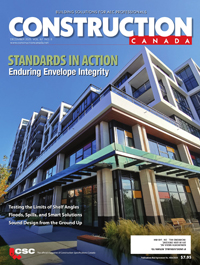Owens Art Gallery: A holistic conservation strategy
2010 conservation strategy
By necessity, the strategy developed for the 2010 conservation project was multi-faceted. It was designed to:
- correct the deficiencies causing the overload condition and thereby better distribute gravity loads to the backup masonry;
- improve how loads could be transferred from the friezes through the columns to the sill units;
- include the repair or replacement of damaged masonry units;
- ameliorate the way loads would be accommodated at cracked sections after repair; and
- enhance the masonry’s ability to withstand the extremes of Canadian weather.
The conservation philosophy mandated the objectives of the strategy should be achieved using materials and techniques sympathetic to the masonry’s sensitive heritage fabric. It was therefore a specified requirement that, to the greatest extent possible, the work should be of the highest quality using traditional materials and techniques, supplemented with proven modern technology that would restore long-lasting structural stability and durability to the building.
Scope of work
The work to correct the overload condition from the roof was carried out under a separate project, which also included re-roofing work and replacement of the overhang soffit panels. (The author was the prime consultant for the exterior masonry restoration project. The contractor was Empire Restoration (New Hamburg, Ont.), the prime consultant for the interior restoration and the re-roofing project was Arthur J Arsenault Architect Ltd. (Sackville, N.B.), the structural engineer was J.M. Giffin Engineering Inc. (Amherst, N.S.), and the contractor was Can-Tech Construction Ltd. (Sackville, N.B.). The author provided sub-consulting services for the masonry-related aspects of the interior restoration). From within the art gallery’s interior, openings were made within the backup masonry at the stub column locations. New structural steel columns were then installed so they were supported on double-wythe backup masonry (Figures 9 and 10) and the masonry rebuilt to encapsulate them. The roof trusses were then permanently connected to the columns and the old stub columns disconnected so loads from the roof superstructure were transferred to the back-up masonry.
The specified slider id does not exist.
With roof loads removed from the inner core rubble, adjustable props were installed to temporarily support the friezes on the front elevation, and the columns were then progressively strapped and removed (Figure 11). The column capitals were also removed. With access now provided to the underside of the frieze surround units, stainless steel helical ties were installed upward at angles to intersect either side of the joints; the objective was to provide more effective spanning of load from the friezes across the tops of the columns once they were relocated.
The cracked columns were subsequently repaired using stitching techniques––short lengths of stainless steel helical ties were installed into pilot holes drilled at angles alternately along the length of the cracks so the ties intersected the cracks. The ties were slightly recessed and the entrance holes repaired using a prepackaged heritage repair mortar designed for sandstone. The crack openings were then cut out and repaired using the same mortar. When they were finally reinstalled, the columns were rotated so cracked sections were predominantly hidden.
Crack openings in masonry units were also chased and repaired using the heritage mortar. Additionally, selected horizontal mortar joints above cracked masonry units were cut out and lengths of deformable stainless steel helical reinforcing rod were grouted into the slots using a high-strength grout. The front portion of the joints was then repointed using a prepackaged hydraulic lime-based repointing mortar designed for use on heritage structures (Figure 12). (This technique is described in this author’s article, “A Tale of Two Towers,” from the November 2008 issue of Construction Canada). The objective of installing joint reinforcement was to improve load transfer away from previously cracked sections, without significantly affecting the masonry’s ability to accommodate the influences of natural movement during extreme temperature changes.







